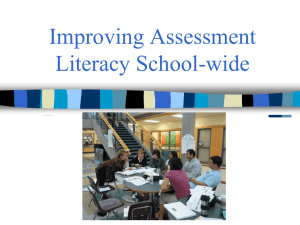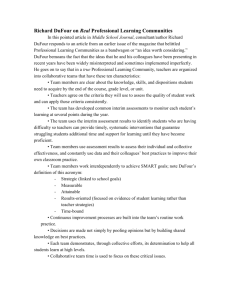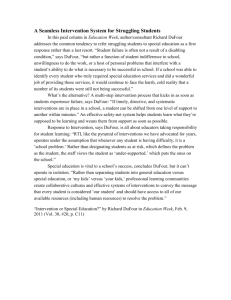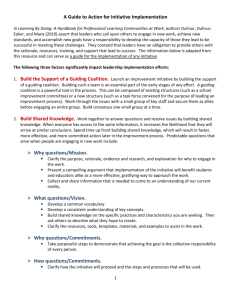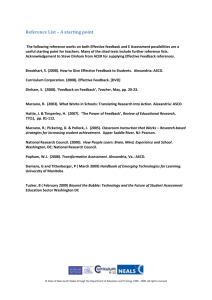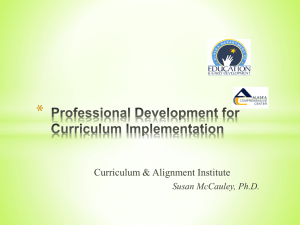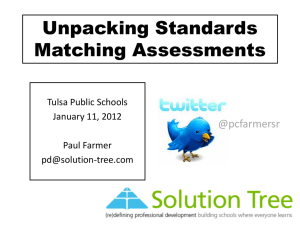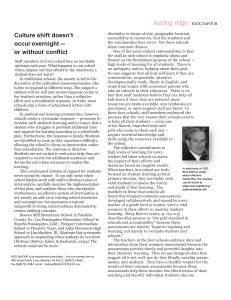Motivating Disengaged Students Power Point
advertisement
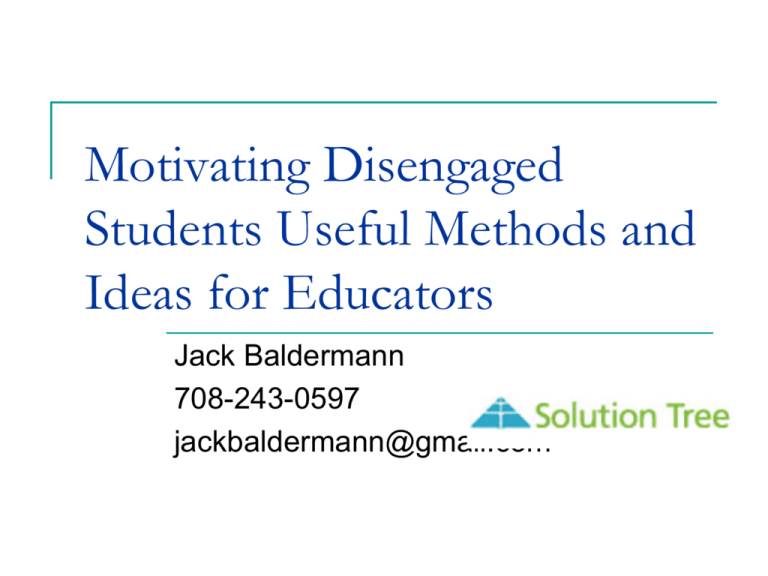
Motivating Disengaged Students Useful Methods and Ideas for Educators Jack Baldermann 708-243-0597 jackbaldermann@gmail.com THE COMMUNITY ENTRUSTS TO US WHAT IS MOST SACRED IN THEIR LIVES. Riverside Brookfield High School: Results - Accomplishments One of the Most Improved High Schools in Illinois/Nation Top 150 – America’s Best High Schools – Newsweek (2006, 2007,2008, 2009) 300% increase in A.P. Scholars 98%+ Graduation Rate Average(2004- 2008) 100% Graduation Rate for Hispanic & African American students (represent 21% of population) (2006) Over 10% increase in PSAE scores (2001-2009) _ Made AYP 2009 74.5% meets or exceeds for Hispanic students on Reading PSAE Philosophy Compassion and Respect Continuous Improvement “Good is the Enemy of Great.” –Jim Collins Leadership – many leaders should emerge “True leadership only exists if people follow when they have the freedom not to.” –Jim Collins Philosophy “I look for people who are psyched and ready to do whatever it takes. Attitude is about being on fire—you’ve got to approach work like it’s a religious experience.” Charlie Trotter, Lessons in Excellence Our Learning Target 1. We will develop a better understanding of why students are not motivated. Get into the mind of the unmotivated student What does the research tell us? Our Learning Target 2. We will identify practices that have been proven to reach unmotivated students. Our Learning Target 3. Each participant will identify at least 3 practices that he/she will start or stop doing. “Instruction begins when you, the teacher, learn from the learner; put yourself in his place so that you may understand…what he learns and the way he understands it.” -Soren Kierkegaard, The Journals, 1854. When you see an unmotivated student, what do you see? Describe this person Give specific characteristics How do you feel about this student? What is your reaction? Name one thing that you hate doing. -------------------------------------(please answer here) Name one thing that you are terrible at. -------------------------------------(please answer here) How would you rate your intelligence? Why are students not motivated? They are protecting their self-worth. Lack of Motivation: Qualities of Unmotivated Students Protecting Self-Worth Use of self-defeating strategies Withholding effort, cheating, procrastination, giving up, acting out, etc. Behavior is a result of a fear of failure Better to attribute failure to lack of effort than to lack of ability James Raffini, Winners Without Losers: Structures and Strategies for Increasing Student Motivation to Learn Why are students not motivated? They feel their effort will make no difference. Why are students not motivated? They do not find meaning or relevance in their work. Lack of Motivation: Qualities of Unmotivated Students Why will I ever need to know this? Without perceived value or purpose, students are less interested in offering their best effort. Cannot find connections between schoolwork and the real world. REVIEW Understanding Why Protecting self-worth Effort will make no difference (given up hope) Do not see relevance How do we sometimes respond? Review: Common mistakes The authoritarian attitude Failure to establish positive relationships Lack of relevance Low/Unclear expectations What do you do to motivate your students? What successful strategies can you list? What works at Wasson Food Modify and adjust as building relaitonship with accountability. 2x10 strategy Modify skills requirements to meet their interests and relevancy. Find a role in the classroom that is significant Set them up for success, confidence Build relationship Catch them doing something good and send Motivation: Strategies for Success Build Strong Relationships The Best Teachers… Have a deep respect for their students and they believe that every student can learn. Know their subjects well and understand human learning. Prepare to teach with rigor and dedication. Have high expectations of each student. Create a learning environment where students are encouraged to think critically. Self-evaluate and make necessary changes. Ken Bain, What the Best College Teachers Do Motivation: Strategies for Success Build Strong Relationships Offer constructive feedback that leads to a growth mindset Believe and care Small victories Focus and build on strengths Ahead of the Curve (DuFour, Reeves, Stiggins, Guskey, Wiliam, Marzano et all) Formative Assessment and Black and Wiliam – “Inside the Black Box” “no other way of raising standards for which such a strong prima facie case can be made” (pg. 139) Inside the Black Box - Black & Wiliam Feedback to any pupil should be about the particular qualities of his or her work, with advice on what he or she can do to improve, and should avoid comparisons with other pupils. For formative assessments to be productive, pupils should be trained in self-assessment so that they can understand the main purpose of their learning and thereby grasp what they need to do to achieve. Formative Assessment Competence Leads to Confidence Identify strengths and learning gaps Provide additional time and practice Implement Corrective Instruction targeted at learning needs Second chance to demonstrate learning Dr. Carol Dweck – Mindset (2006) Over 20 years of research on student motivation Intelligence is not fixed “A few modern philosophers…assert that an individual’s intelligence is a fixed quantity, a quantity which cannot be increased. We must protest and react against this brutal pessimism…With practice, training, and above all method, we manage to increase our attention, our memory, our judgment and literally to become more intelligent than we were before.” (Alfred Binet-Modern Ideas About Children) Growth Mindset vs. Fixed Mindset C. Dweck & N. Holmes-Mindset p. 245 Fixed Mindset Intelligence is static Leads to a desire to look smart and a tendency to Avoid challenges Get defensive or give up easily See effort as fruitless or worse Ignore useful constructive criticism Feel threatened by the success of others Avoid negative judgments Leads to achieving less than their full potential Growth Mindset Intelligence can be developed therefore leads to a desire to learn and therefore a tendency to Embrace challenges Persist in the face of setbacks See effort as the path to mastery Learn from criticism Find lessons and inspiration in the success of others As a result they reach ever higher levels of achievement Provide a secure environment that permits children to fail without penalty. Teach that struggle is natural in the learning process. “The passion for stretching yourself and sticking to it even (or especially) when it is not going well, is the hallmark of the growth mindset.” (Dweck p.7) Strategic Comprehension: A Model for Content Area Literacy Across the Curriculum Traditional Format Reading Assignment Given (or activity) Independent Reading/Doing Discussion to see if students learned the main concepts Phase I Frontloading Key: Vocabulary, Big Ideas, Clarify Purpose, Mental Anchors, Questions, etc. Phase II Teacher Mediated Teach strategies directly Read more than once Chunk text Structured discussion Graphic Organizers Phase III Activities to reinforce & extend reading (Kevin Feldman) Alternative to Tradition Questioning in a Classroom Setting Question to the Whole Class followed by random (usually the most motivated) hand raising. - Place students in pairs and call on all students Difficult Conversations 15 years of research at the Harvard Negotiation Project tells us… Douglas Stone, et al., Difficult Conversations, 1999 Difficult Conversations Seek Learn first to understand their story Problem-solve together Difficult Conversations Think like a mediator Consider the Third Story You must first understand before you can motivate students Difficult Conversations Make it a learning conversation Adopt the curiosity stance Motivation: Strategies for Success Make Relevant Lessons “Whatever the expected learning outcomes, there must be a direct connection with the ‘real world’ outside the classroom. Application of acquired learning is most significant in life-like situations.” Daniel J. Burke, “Connecting Content Motivation: Education’s Missing Link” “Whereas many schools operate as if their primary purpose is to ensure that children are taught, PLCs are dedicated to the idea that their organization exists to ensure that all students learn essential knowledge, skills, and dispositions. All the other characteristics of a PLC flow directly from this epic shift in assumptions about the purpose of the school.” Richard DuFour, Rebecca DuFour, Robert Eaker & Thomas Many Learning by Doing The Professional Learning Community 1. Exactly what is it we want all students to learn? 2. How will we know when each student has acquired the essential knowledge and skills? 3. What happens in our school when a student does not learn? 4. How will we respond when they already know it. DuFour et al., Whatever It Takes, 2004. p. 21-24 Isolation Collaboration “Schools can guarantee all students have access to the same essential outcomes only when the teachers… work together to clarify and commit to those outcomes.” DuFour et al., Whatever It Takes, 2004. p. 60 Pyramid of Interventions Special Education Placement Case Study Evaluation Child Review Team Mentor Program Placement Guided Study Program Student Assistance Team Referral SST and Teacher Conference with Parent Social Work Contact/Peer Mediation Student Placement on Weekly Progress Reports Counselor Conference with Student and Parent Good Friend Program Counselor Phone Calls to Parents Counselor Meeting with Student Counselor Watch/Survival Skills for High School Freshman Advisory/Freshman Mentor Program DuFour et al., Whatever It Takes, 2004. p. 210 Riverside Brookfield High School Response to Interventions (RtI) Strategies Individualized Strategies Administrative Teaming, Alternative Placement, Alternative Schedule, Behavior/Academic Contracts, Classroom Observation, IEP, 504 Accommodation Plan, Intervention Teams, Outside Referrals, Progress Monitoring, Records Review, Weekly Progress Reports Targeted Strategies Academic Support, ADA, Ambassador Program, Behavior/Academic Referrals, Blitz, Classroom Profiles, Correspondence Courses, Counselor Watch Program, Drug & Alcohol Counseling, ESL, Executive Functioning Program, Freshman Academic Success Seminar, Learning Resource Center, National Honor Society Tutoring, Parent/Student/Counselor/Teacher Meetings, Parent Support Groups, Progress Monitoring, Read 180, Social Worker Groups, Study Skills Course, Summer School, Credit Recovery, Transition Teams, Truancy Tickets, Zone Program Universal Strategies Before School/After School Help, Articulation with Feeder Schools, CAP, Clubs/Sports/Extra-Curricular Activities, College Planning Workshops and Programs, Common Assessments, Drug/Alcohol Prevention Presentations, Ed-Line, Freshman Orientation, Naviance, Parent/Teacher Conferences, Progress Reports, Universal Freshman Screening, W/F List S.M.A.R.T. Goals (Specific/Measurable/Attainable/Realistic/Time Bound) Results by Mike Schmoker Big Hairy Audacious Goals by Jim Collins School Goal Setting (PLC’s) by DuFour, DuFour & Eaker The Carrot Principle by Gostick & Elton Why Goals? The Power of Goals Provides Focus Sense of Accomplishment for Teachers/Students Pride McREL’s meta-analysis of 27 studies on successful school leadership found: Set “non-negotiable” goals for achievement Involve others in setting these goals Continually monitor progress and make corrections when needed Focus resources, especially for training, on district-wide goals Robert Marzano &J. Timothy Waters Create quality instruction The Big Four Improving Student Learning One Teacher at a Time Jane E. Pollock 1. Create robust, clear learning targets. 2. Design lessons around benchmarks. 3. Assessment linked to targets and instruction. 4. Give criterion-based feedback. Let’s Think About Grades… Where did the 100-pt./AF grading scale originate in the U.S.? The system is supported by what mathematical principles, logic, and/or research? Results The 100-pt./A-F grading scale is flawed, arbitrary, and it lacks a mathematical foundation. Rethink zeroes and uneven intervals. Consider Standards Based grading. Uneven Intervals vs. Even Intervals A 91+ A 4 B 81-90 B 3 C 71-80 C 2 D 61-70 D 1 F Zero F Zero Douglas B. Reeves. The Learning Leader, 2006. Summary/Review Understand & empathize with the unmotivated student Implement formative assessment Cultivate a growth mindset Build confidence and hope Maintain a quality relationship Create relevance Beware: authoritarian attitude Maintain high expectations Summary/Review Differentiate instruction/formative assessment Establish S.M.A.R.T. goals Address test anxiety & study skill deficiencies Rethink grading/evaluation Utilize pyramid of interventions Focus on learning vs. performance Collaborate with colleagues List at least 3 things that you will stop doing to unmotivated students. 1. 2. 3. 4. 5. ----------------------------------------------------------------------------------------------------------------------------------------------------------------------------------------------------------------------------------------------------------------------------------------- Create a “start/continue to do” list of at least 3 ideas to motivate students. 1. 2. 3. 4. 5. ----------------------------------------------------------------------------------------------------------------------------------------------------------------------------------------------------------------------------------------------------------------------------------------- Bibliography Ahead of the Curve: The Power of Assessment to Transform Teaching and Learning. Solution Tree, 2006. Bain, Ken. What the Best College Teachers Do. Cambridge, MA: Harvard University Press, 2004 Ben-Shahar, Tal. Happier. New York: McGraw-Hill, 2007. Black, P. & Wiliam, D. Inside the Black Box: Raising Standards Through Classroom Assessment. 1998 Burke, Daniel J.. "Connecting Context and Motivation." Peabody Journal of Education 70. 2. Winter 1995 66-81. 10 July 2007 <http://www.jstor.org>. Csikszentmihalyi, Mihaly. Flow: The Psychology of the Optimal Experience. New York: Harper Collins, 1990. Deci, E.L., Koestner, R. and Ryan, Richard M., "Extrinsic Rewards and Intrinsic Motivation in Education: Reconsidered Once Again." Review of Educational Research 71.1. Spring, 2001 1-27. 10 July 2007 <http://www.jstor.com>. Dufour, R., Dufour R., Eaker R., & Karhanek, G. Whatever it Takes. Bloomington, IN: Solution Tree, 2004. Dufour, R. & Eaker, R. Professional Learning Communities at Work. Bloomington, IN: National Educational Service, 1998. Dweck, C.Mindset. New York: Random House, 2007. Frymier, Jack R.. "Motivation: The Mainspring and Gyroscope of Learning." Theory into Practice 9. 1. Feb 1970 23-32. 10 July 2007 <http://www.jstor.org>. Gray, T. & Madson, L. “Ten Easy Ways to Engage Your Students”. College Teaching. Spring 2007: 83-85. Heen, S., Patton, B., & Stone, D. Difficult Conversations. New York: Penguin, 1999. Hidi, S., Harackiewicz, J.M., "Motivating the Academically Unmotivated: A Critical Issue for the 21st Century." Review of Educational Research 70.2. Summer, 2000 151-179. 09 July 2007 <http://www. jstor.org>. Lepper, Mark R.. "Motivational Considerations in the Study of Instruction." Cognition and Instruction 5. 4(1988) 289-309. 10 July 2007 <http://www.jstor.org>. Levine, Mel. The Myth of Laziness. New York: Simon & Schuster, 2003. Marzano, Robert J. Classroom Assessment and Grading that Work. Alexandria, VA: Association for Supervision and Curriculum Development, 2006. Marzano, Robert J. Transforming Classroom Grading. Alexandria, VA: Association for Supervision and Curriculum Development, 2000. Marzano, Robert J. What Works in Schools: Translating Research into Action. Alexandria, VA: Association for Supervision and Curriculum Development, 2003. Marzano, R.J., Norford, J.S., Paynter, Pickering, D.J., & Gaddy, B.B. A Handbook for Classroom Instruction that Works. Alexandria, VA: Association for Supervision and Curriculum Development, 2001. Continued Marzano, R.J., Pickering, D.J., & Pollock, J.E. Classroom Instruction that Works. Alexandria, VA: Association for Supervision and Curriculum Development, 2001. Milton, Ohmer. Making Sense of College Grades: Why the Grading System Does Not Work and What Can Be Done About It. San Francisco: Jossey-Bass, 1986. Pollock, Jane E. Improving Student Learning One Teacher at a Time. Alexandria, VA: Association for Supervision and Curriculum Development, 2007. Raffini, James. Winners Without Losers: Structures and Strategies for Increasing Student Motivation to Learn. Boston: Allyn and Bacon, 1993. Reeves, Douglas B. The Learning Leader. Alexandria, VA: Association for Supervision and Curriculum Development, 2006. Schlechty, Phillip C. Shaking up the Schoolhouse. San Francisco: Jossey-Bass, 2001. Schmoker, Mike. Results Now. Alexandria, VA: Association for Supervision and Curriculum Development, 2006. Tileston, Donna W. 10 Best Teaching Practices. Thousand Oaks, CA: Corwin Press, 2005. Wigfield, A., Eccles, J.S., and Rodriguez, D., "The Development of Children's Motivation in School Contexts." Review of Research in Eductaion 23(1998) 73-118. 09 July 2007 <http://jstor.org>. Wolk, Steven. “Why Go to School?”. Phi Delta Kappan. May 2007: 648-658. Zeidner, Moshe. Test Anxiety: The State of the Art. New York : Plenum Press, 1998.
